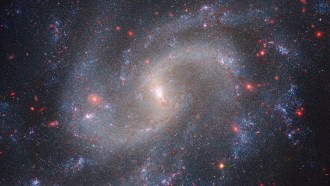Space
-
 Cosmology
CosmologyHow did dark matter shape the universe? This physicist has ideas
Theoretical physicist Tracy Slatyer proposes new scenarios for dark matter and helped discover the Fermi bubbles.
By Adam Mann -
 Particle Physics
Particle PhysicsA neutrino mass mismatch could shake cosmology’s foundations
Cosmological data suggest unexpected masses for neutrinos, including the possibility of zero or negative mass.
-
 Space
SpaceMeet Porphyrion, the largest pair of black hole jets ever seen
The two plasma fountains, spanning 23 million light-years, could shape cosmic structures far beyond their home galaxy.
-
 Physics
PhysicsHow to spot tiny black holes that might pass through the solar system
Flybys of primordial black holes may occur once a decade. Tweaks to the orbits of planets and GPS satellites could give away their presence.
-
 Space
SpaceHow a dying star is similar to a lava lamp
In a first, astronomers captured how convective forces power the quick bubbling movement of gas cells on the surface of a distant, massive star.
-
 Planetary Science
Planetary ScienceScientists find a long-sought electric field in Earth’s atmosphere
The Earth’s ambipolar electric field is weak but strong enough to control the shape and evolution of the upper atmosphere.
-
 Cosmology
CosmologyIn an epic cosmology clash, rival scientists begin to find common ground
Different measurements of the cosmic expansion rate disagree. The James Webb telescope could determine whether that disagreement is real.
-
 Space
Space2 spacecraft caught the waves that might heat and accelerate the solar wind
Data from NASA’s Parker Solar Probe and ESA’s Solar Orbiter might have cracked an enduring solar riddle. But not everyone yet agrees.
By Adam Mann -
 Planetary Science
Planetary ScienceThe Webb telescope’s peek into a stellar nursery finds baby planets too
Images by the James Webb telescope of six Jupiter-sized worlds, one of which may have a moon-forming disk, reveal clues into how planets and stars form.
By Adam Mann -
 Space
SpaceThe historic ‘Wow!’ signal may finally have a source. Sorry, it’s not aliens
One of the best possible signs of extraterrestrial communication may have an astrophysical explanation — albeit a weird one.
-
 Astronomy
AstronomyThe nearest midsized black hole might instead be a horde of lightweights
Astronomers recently reported that the Milky Way star cluster Omega Centauri hosts an elusive type of black hole. A new study says it does not.
By Ken Croswell -
 Astronomy
AstronomyA distant quasar may be zapping all galaxies around itself
Star formation has ceased within at least 16 million light-years of the quasar. A similar phenomenon may have fried the Milky Way when it was young.
By Ken Croswell